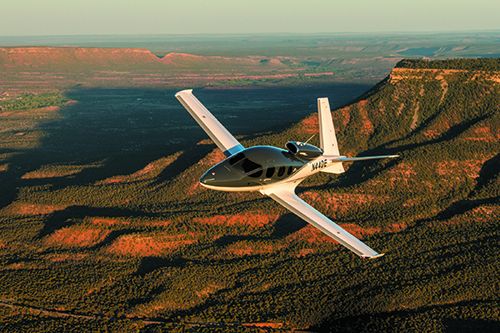If its success with the SR-series piston line isn’t impressive enough, Cirrus has delivered nearly 150 SF50 Vision Jets since earning the type certificate in 2016. As was the plan, the majority of those buyers stepped up from million-dollar SR-22T piston models.
And with order books full for the single-engine jet, Cirrus has been working on improving the Robert J. Collier Trophy award-winning airplane. Some changes to the G2 (for second-generation) are major and others are subtle, but combined they make an already impressive airplane better in a lot of ways.
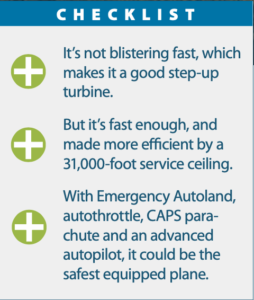
The Vision Jet I flew for this report had the Safe Return Autoland system, which is currently in certification and will be standard. We covered it extensively in the December 2019 Aviation Consumer, so we’ll only touch on it in this report.
TWEAKS BIG AND SMALL
Other than the G2 markings on the paint work, you can tell a second-gen Vision from a G1 by looking at the surface of the wings. Gone are the boundary layer energizers (BLEs) that were intended to create a turbulent airflow over the wing so the flow doesn’t separate before hitting the ailerons. Roll-axis handling seems even better after ditching the BLEs and by adding a simple tab on the trailing edge of the ailerons, catching the airflow so the control surfaces remain as effective. Stall speed with the gear and flaps down at the 6000-pound MTOW is 67 knots.
Overall, the airframe’s construction is unchanged, although the V-tailed structure is still interesting to look at and there’s some clever aero engineering going on. As you’d expect from Cirrus, the fuselage structure is primarily carbon fiber. The forward part up to the aft cabin bulkhead station is fabricated separately and assembled in a fixture, as is the tailcone. The carbon fiber structure below the jet engine is covered by a titanium firewall. Yes, the Williams turbofan jet engine sits right above the rear cabin occupant’s heads. More on cabin noise in a minute.
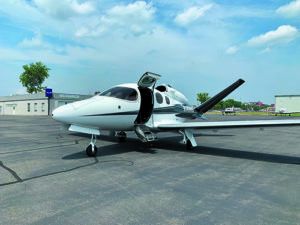
The high aspect ratio carbon fiber wing structure houses the fuel bays (one in each wing) between the two spars. Each tank holds 148 usable gallons of Jet A. The ailerons and wing flaps are aluminum and all of the control system components including the aileron push rods and flap torque tubes are routed along the rear side of the aft spar. Carbon fiber wingtips with smart Whelan LED lights attach to the upper and lower wing skins.
The empennage consists of two large carbon fiber surfaces in a V-tail configuration, along with two ventral fins that have attach points for the aircraft’s yaw stability augmentation system (Yaw SAS) flight surfaces.
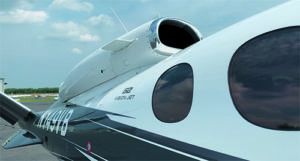
There’s also a yaw stability augmentation system that’s controlled by the integrated autopilot’s servo motor. The control surface, which is hinged to the ventral fin, rotates asymmetrically to actively augment lateral and directional stability. The system shuts off when the autopilot yaw damper automatically engages above 200 feet. No wagging of the tail like other V-designs.
And when it comes to protecting the airframe from ice, the SF50 uses a variety of mostly conventional methods, unlike TKS fluid primarily used on the piston models. The wing and stabilizer leading edges have pneumatic deice boots, the engine inlet is protected by engine bleed air and integral electric heaters protect the pitot probes and AoA (angle of attack) vane. The windshield and radome are protected by TKS fluid and a reservoir holds three gallons of the slimy liquid. The ice protection system is smart and automated.
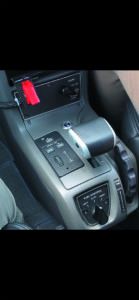
As an example, the wing and stabilizer pneumatic boots have three operating modes. When on, the controller automatically and continuously cycles the three deicer zones (stabilizer, lower wing and upper wing) for six seconds each, every 60 seconds. As you’d expect, even with this smart system, takeoff is prohibited with any frost, ice, snow or slush adhering to the wings, stabilizers or control surfaces,
And regarding the AoA vane—you might recall the FAA AD that was slapped on the Vision Jet last year because of faulty hardware that caused an uncommanded pitch change in some of the jets. That’s been long resolved and Cirrus has replaced all of faulty vanes in the existing fleet.
HIGH-ALTITUDE EFFIECIENCY
The first-gen Vision Jet was limited to 28,000 feet because it wasn’t RVSM certified (reduced vertical separation minimums), but the G2 is RVSM compliant and now goes to 31,000 feet. Just that extra 3000 feet of altitude means you can either fly farther, or load the cabin with more passengers or stuff. Using NBAA IFR range minimums, a 1300-pound payload means you can fly the Vision Jet a touch over 1200 nautical miles at best economy, or 240 knots true. Push the speed to 300 knots true and you can still fly 1000 nautical miles.

Even with the higher altitude certification, the G2 has the same 8000-foot cabin altitude and the differential in the pressurization system is now 7.1 PSI, up from 6.4 PSI in the original Vision Jet.
Cirrus’ Matt Bergwall said that the typical mission is around 800 miles with 950 pounds of payload. It’s easy—go slower to fly farther.
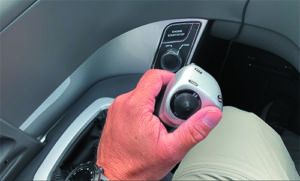
Like the G1, the latest Vision Jet is powered by a Williams International FJ33-5A turbofan that produces 1846 pounds of thrust. The -5A engine was certified in June 2016 (the original FJ33 was certified in 2004) and Williams designed the engine series for light jets in the 5000- to 9000-pound GTOW class.
The engine, which has dual-channel FADEC (full authority digital engine control), sits atop of the airframe just aft of the passenger cabin and has a dry weight of 308 pounds and a 4000-hour TBO.
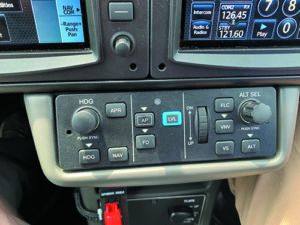
It’s a whole other world in the high flight levels and for that the aircraft has some built-in failsafe. If there is a loss of cabin pressure when the pressure altitude is sensed to be above 14,900 feet, the EDM (emergency descent mode) in Garmin’s integrated autopilot descends the aircraft to 14,000 feet at a speed reference that’s 10 knots below the current structural speed limit and the autopilot holds it there. During the descent the EDM reduces engine thrust to idle. Once at a safe altitude, the EDM will bring the throttle back to N1, or 83 percent.
BETTER CABIN EXPERIENCE
The cabin can seat up to five adults and two children, and there are three different seating configurations available. The Executive version has wider seats in the number three and five seating position. There’s the more traditional Family configuration, which has three cabin seats with two optional child seats for a total of seven (including pilot and copilot), while the Complete seat arrangement is a combination of executive and family seats, plus a center console with folding tray tables.
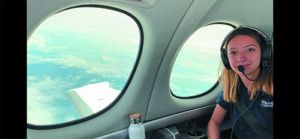
The fit and finish of the G2’s interior just seems better. Cirrus upgraded the carpeting and added small conveniences that mean a lot, including kangaroo pouches in the front of each seat to hold a smartphone, and a side pouch to hold an iPad. The aircraft I flew also had a 22-inch drop-down LED monitor in the overhead for passenger entertainment. There’s the expected USB ports, good cabin lighting, plus dedicated environmental controls for the rear cabin.
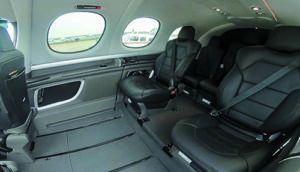
Up in the cockpit, Cirrus worked hard to ease transitions from the SR22 cockpit. I’m not going to say that flying the Vision Jet is like flying a big SR22 as some have because it just isn’t. But if you have even limited experience in the Garmin Perspective-equipped SR22, the jet will be a familiar environment. The latest avionics is the Garmin Perspective+ G3000 suite, with PFD, MFD and three touch controllers.
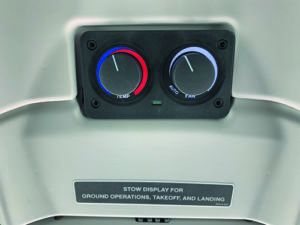
To power and start the aircraft (the Vision Jet has a two-generator, two-battery 28-volt electrical system with a main, essential and emergency bus), there are two rechargeable True Blue Power lithium-ion batteries for starting and for emergency. The new batteries mean faster and cooler engine starts and a sizable weight savings.
The main reason SR pilots should feel at home in the Vision Jet’s cockpit is because the battery and generator switches are in a familiar bolster panel on the pilot’s subpanel. This row of rocker switches has been used in the SR since day one. I think Cirrus nailed the ergos in the jet just as they did in the pistons. Everything seems logically placed.
FLYING IT
Once in the seat and ready to fire the Williams, you run the integrated checklist on the Garmin MFD. Forget some of what you know about starting a turbine because the Vision Jet makes it foolproof and easier than ever. The engine has dual, software-controlled igniters that alternate with each successive engine start. Simply turn the engine start rotary knob to the Run position. That turns on the electric fuel boost pump. Press and release the Engine button in the middle of the rotary knob and the FADEC does the rest—from commanding the ignition to scheduling the flow of fuel once there’s sufficient N2 speed. The igniters shut off automatically when the computer senses a successful start.
But if there was an excessive rise in ITT (or if the Williams fails to ignite), the FADEC will automatically abort the start. Out of the chocks the Vision needs a blip of the power lever to get rolling and like the SR piston models it has a fully castering nosewheel. The nosegear strut is a conventional air/oil oleo shock/strut extending from a trunnion and has self-centering cams to lock the wheel straight when the strut is extended and the landing gear is retracted.
Lining up on Hartford Brainard Airport’s Runway 20 in Connecticut on a hot day (ISA+15) with flaps set at 50 percent and the thrust lever in the takeoff position, the drill was to pitch for 5 degrees on the horizon, and the flight director command bars lead the way. Once rolling the 90-knot rotation speed doesn’t come at lightning speed, but it’s fast enough and loaded with three average-sized people and full fuel the jet was off in roughly 2500 feet. With a positive rate of climb and the gear in the wells, the airplane settled into a 1500-FPM climb. The yaw stability system automatically engages at 200 feet in the climb and the airplane is stable and reasonably pleasant to hand fly, although you’ll want to use the electric trim. There are several centering springs that help with roll, pitch and yaw stability and you feel them when hand flying. Like the SR22/20, if you don’t properly trim, especially at slow speeds, you will lose the battle to fairly heavy control pressures. The Vision has roll trim, via a dedicated servo motor, and it’s easy to keep the airplane in trim.
The takeoff thrust setting is limited to five minutes maximum, and the POH advises to pull it back to the MCT (max continuous power) position within two minutes. “Engine life and maintenance costs are contingent upon observing the two-minute limit of takeoff thrust for every 72 minutes of flight,” it goes on to say. The engine also has a deck-angle limitation and the book says to avoid a deck angle of 20 degrees or more for longer than 30 seconds. That’s pretty steep and uncomfortable in initial climb.
Step-climbing to FL310, we were seeing 1500 FPM, but on cooler days the Vision will easily climb at 2000 FPM, which I’ve experienced on other flights. Once at our final stop at FL310 the Vision clocked in at 303 knots true, burning 60 GPH of Jet A.
There’s no speedbrakes or spoiler on the Vision Jet, but it’s easy to slow down with the 210-knot landing gear extension speed. You can even feed in the first notch (50 percent) of flaps at 190 knots. A thrust setting of 35 percent works for a 140-knot approach speed, and you make normal landings with full flaps. If you need to make a quick stop on the runway, don’t look for a thrust reverser—it doesn’t have one. But the airplane does, like the piston line, have excellent Beringer brakes and wheels.
AUTOTHROTTLE
A major new system in the G2 Vision Jet is Garmin’s autothrottle. It trickles down from larger Garmin-equipped jets and is integral to the Safe Return Autoland, which flies a precision GPS approach to a full-stop landing at the best-suited airport, based on landing criteria, weather and other algorithims. It also has automatic braking and engine shutdown.
The autothrottle is activated with a button to the left of the thrust lever, while a thumb wheel is used to dial in the speed you want the autothrottle to maintain. Aside from Manual mode, it interfaces with the Perspective system’s FMS via a mode selector button. The FMS is likely the most common mode because it follows the active flight plan, setting the precise speeds for all phases of flight.
As a real-world example, in the FMS profile the system can hold a climb speed of 155 knots (and the corresponding Mach number above 18,000 feet), an airspeed limit of 250 knots at 10,000 feet and a terminal speed limit of 200 knots for flying the airport environment. In cruise, the system keeps the speed off the barber pole, or the max operating Mach speed. For descent it will maintain 250 knots (or .52 Mach) and as you get closer to the airport it slows the airplane to 185 knots—a safe structural speed for dropping the flaps. With flaps at 100 percent, the autothrottle slows the airplane to 95 knots for the approach to landing.
Essentially what this automation means is with the autothrottle coupled with the FMS profile, you don’t have to touch the thrust lever from the initial climb to 200 feet on the descent. The autothrottle also interacts with the Garmin autopilot’s flight envelope protection system, guarding against underspeed and overspeed conditions. It’s remarkably smooth and accurate, and just as tight when the Safe Return is flying.
I sat hands crossed while the Safe Return flawlessly flew the GPS approach and touchdown to the huge Runway 27 at Plattsburgh International Airport in New York.
CONCLUSION
I think the second-generation Vision Jet packs a huge punch for the $2.75 million (fully loaded) price tag. A lighter airframe (thanks mainly to the lighter batteries) and the ability to fly it just 3000 feet higher means it burns less fuel, you can carry more of it (roughly 150 pounds more) for more range on intermediate trips, or you can load the cabin with another person or more stuff. But, pilots aren’t the only ones who will benefit from the G2’s improvements.
During my time with the airplane I took off my headset and climbed into the rear cabin and was surprised at how we’ll Cirrus reduced the cabin noise—it’s a huge improvement over the old airplane. And overall improvement is a good way to describe the G2 Vision Jet.
With autothrottle, pending Safe Return emergency landing system and the ability to fly at FL310 it’s tough to think Cirrus could make the Vision Jet better, but you can bet it’s already working on it for the G3.

